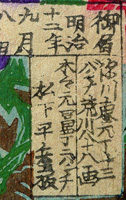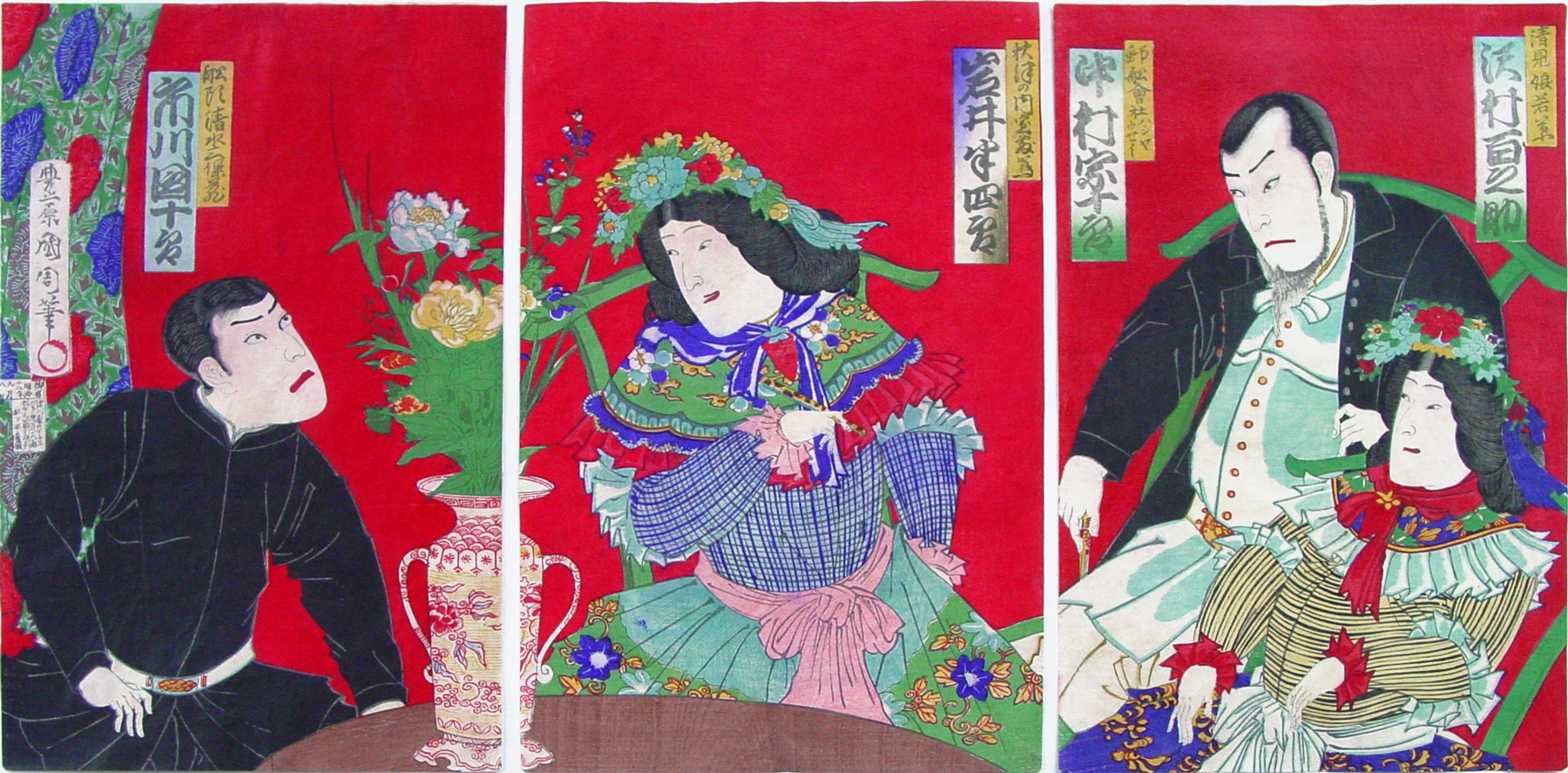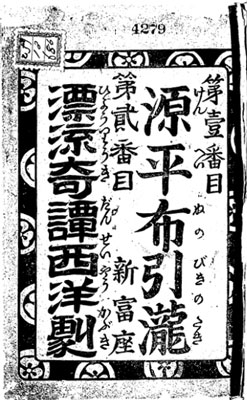About This Print
Kunichika portrays a scene from the "cropped-hair" play A Strange Tale of Castaways: A Western Kabuki. Written by the renowned playwright Kawatake Shinshichi II (1816-1893), it tells the tale of a "fisherman [Shimizu no Mihozō] who is separated from his father when their boat wrecks. Rescued and brought to San Francisco by a steamship, he embarks on a journey to Washington... While crossing the desert plains, his train is attacked by Indians, and he is kidnapped by the chief. One adventure leads to another -- and to Europe, where Mihozō reunites with his father, Gozaemon, at an opera in Paris. The curtain closes with the two men agreeing that 'Nothing is as deep as the kindness of people in other countries.'"1
Morita Kan'ya XII (1846-1897), owner of the Shintomi-za theater, staged this play in September 1879, using actors and actresses in a touring English troupe to perform in several scenes along with Japanese actors (see "The Actors Pictured" below.) Several Italian-style operettas were inserted into the play. Kan'ya's radical staging was not welcomed by the audience and comments such as "What the Westerners were saying did not make sense at all" and "The voice of a British actress sounded just like the barking of a Western dog" were reported.2 In commenting on the female character Wakaba with her Western dress, played by the onnagata Sawamura Hyakunosuke, an actors' critique stated "When he [Sawamura] sits down in a chair, however, we notice the long torso of his male body and unsightly behind. He later fixes this, thus hiding his behind, which was an improvement."3 The play's failure resulted in a loss of over 20,000 yen to Kan'ya, which he never recovered from.4
Cropped-Hair Plays (zangiri mono)
Source: Kabuki Plays on Stage Restoration and Reform, 1872-1905, vol. 4, ed. James Brandon and Samuel Leiter, University of Hawai'i Press, 2003, p. 18.
"The term 'cropped-hair play' came into use to identify plays about contemporary life because, in 1871, a government regulation had advised citizens to cut their hair short in the Western manner, wear uniforms or informal clothing, and abandon wearing swords. The Meiji emperor cut off his topknot in 1873, thereby setting a seal of approval on the new hairstyle."
1 William Wetherall's website http://members.jcom.home.ne.jp/yosha/nn/articles/Tonichi_Iwakura_Embassy.html
2 National Diet Library website article "Theatrical Performances and Theaters in the Meiji Period (1): Shintomiza - Morita Kanya's Western Influence"
3 "Customs of the Meiji Period and Kabuki's War Dramas" by Akira Kamiyama as translated by Joseph Ryan, appearing in Comparative Theatre Review, Vol. 11, No. 1 (English Issue), March 2012, p. 11.
4 A Kabuki Reader: History and Performance, Samuel L. Leiter, ed., M.E. Sharpe, 2002, p. 149.
The Actors Pictured
Left Panel: Ichikawa Danjōrō IX <9>市川 団十郎 in the role of 船頭 清水三保蔵 (the boatman Shimizu no Mihozō)
Center Panel: Iwai Hanshirō VIII <8>岩井 半四郎 in the role of 秋津の内室敷島 (the wife of rich and influential Akizu Takeshi)
Right Panel (standing): Nakamura Sōjūrō <1>中村 宗十郎 in the role of 郵船会社 ハシヤウセイ (cargo ship company employee Hashiya Usei)
Right Panel (sitting): Sawamura Hyakunosuke <0>沢村 百之助 in the role of 清見娘若葉 (Kiyome's daughter Wakaba)
For information on the actors see the article The Kabuki Actor on this site.
4 A Kabuki Reader: History and Performance, Samuel L. Leiter, ed., M.E. Sharpe, 2002, p. 149.
The Actors Pictured
Left Panel: Ichikawa Danjōrō IX <9>市川 団十郎 in the role of 船頭 清水三保蔵 (the boatman Shimizu no Mihozō)Center Panel: Iwai Hanshirō VIII <8>岩井 半四郎 in the role of 秋津の内室敷島 (the wife of rich and influential Akizu Takeshi)
Right Panel (standing): Nakamura Sōjūrō <1>中村 宗十郎 in the role of 郵船会社 ハシヤウセイ (cargo ship company employee Hashiya Usei)
Right Panel (sitting): Sawamura Hyakunosuke <0>沢村 百之助 in the role of 清見娘若葉 (Kiyome's daughter Wakaba)
For information on the actors see the article The Kabuki Actor on this site.
The Playbill
Print Details
| IHL Catalog | #470 |
| Title (Description) | Sawamura Hyakunosuke, Nakamura Sōjūrō, Iwai Hanshirō VIII and Ichikawa Danjūrō IX (in A Strange Tale of Castaways: A Western Kabuki) A Strange Tale of Castaways: A Western Kabuki (Hyōryō Kidan Seiyō Kabuki 漂流奇談西洋劇) note: sometimes translated as The Wanderer’s Strange Story: A Western Kabuki; the National Diet Library titles the play Genpei Nunobiki no Taki Hyoryu Kidan Seiyo Geki. |
| Artist | Toyohara Kunichika (1835–1900) |
| Signature | Toyohara Kunichika hitsu |
| Seal | red Toshidama seal beneath signature |
| Publication Date | September 1879 |
| Publisher |  |
| Printer | |
| Carver | |
| Impression | excellent |
| Colors | excellent |
| Condition | good- trimmed to image; separate sheets; not backed |
| Genre | ukiyo-e; nigao-e; yakusha-e |
| Miscellaneous | |
| Format | vertical oban triptych |
| H x W Paper | 13 7/8 x 9 3/8 in. (35.2 x 23.8 cm) each sheet |
| Literature | |
| Collections This Print | Tokyo Metropolitan Library M348-014 |




